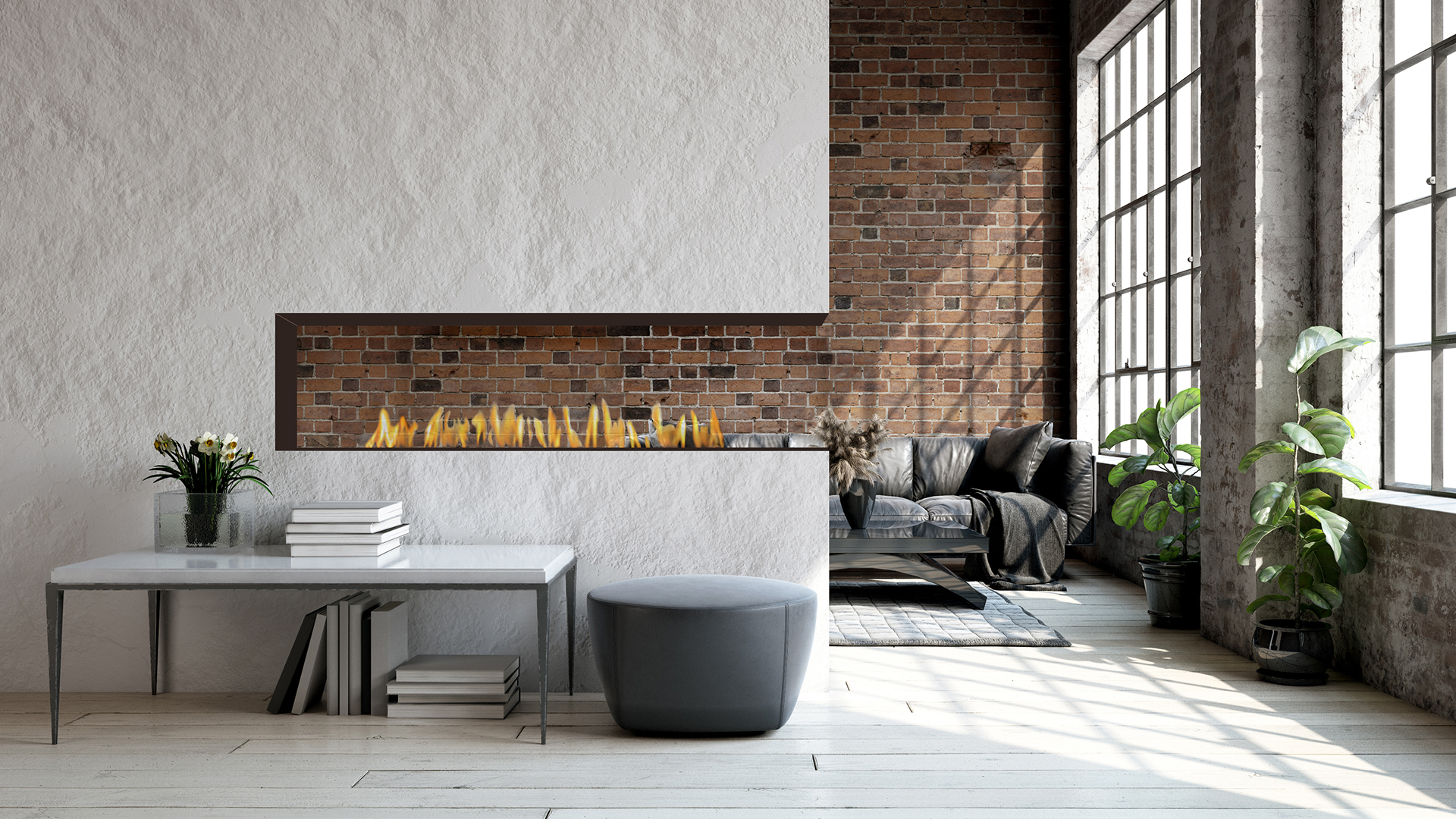They’ve been around for almost 40 years now, but vent free gas fireplaces are still viewed skeptically in the public domain. In a sense, they are the victims of their own success. As their sales numbers have ticked up year after year, the questions about their indoor air quality impact get magnified, especially in the sea of information spread across social media and the internet.

H Series Peninsula Fireplace by European Home: All of European Home’s vent free gas fireplaces are ANSI Certified.
Like any issue with two sides, there’s anecdotal evidence – the proverbial “my neighbor told me…” – and there’s factual evidence based on scientific results. But beware, some science can be fudged to dovetail to an established belief. It’s always good to question the source (even this one!) as well as any preconceptions you may have.
Want to speak to a professional about vent-free fireplaces?
We do this for a living.
Let’s First Look at: What Makes a Vent Free Fireplace a Smart Option?
A vent-free fireplace is very much as described: it has been designed to burn without the need for venting. Unlike a direct vent fireplace, which vents to the outside and brings in combustion air to a sealed firebox, a ventless fireplace uses available room air to provide the oxygen necessary for combustion.

Given their architectural limitations for venting, large commercials spaces, apartments and condominiums are a natural fit for a ventless gas fireplace. H Series 3-Sided gas fireplace installed in the St. Gregory Hotel: Washington, D.C.
The number one reason one would benefit from a vent-free gas fireplace is that they eliminate the need to make a vent connection to the outside.
Why is this so important? If you live in an apartment building, condominium or a home with a challenging layout, you already have your answer.
Say you’ve always dreamt about putting a linear gas fireplace against a vacant living room wall in your home. You can close your eyes and envision this elegant wall of flame, with perhaps, a modern trimless finish and a custom mantel above.
However, it’s an interior wall and there’s a bathroom behind it, a bedroom above it, and no way to run the venting for a direct vent fireplace that will conform to the manufacturer’s standards. What do you do? Abandon your dream? Of course not! You could consider installing a ventless gas fireplace instead.
More Heat + No Vent Costs = Significant Savings
And then there’s the heat output. By eliminating venting, 99% (efficiency) of the heat generated by a vent-free fireplace stays in the room. The maximum BTU (British thermal unit) allowed for a ventless fireplace is 40,000. But don’t forget, they are considered supplemental heat sources, not central heating systems.
Here’s a BTU calculator that will help determine heating needs for a particular room based on square footage. Keep in mind, there are a number of mitigating factors that cannot be inputted into an online tool. A site visit from a local hearth professional is always best. Any way you do the math though, it’s clear that a ventless fireplace offers maximum efficiency.
Moreover, the cost savings of both installation and operation of a vent-free gas fireplace can be substantial.
Efficient heat translates into lower overall heating costs but that is really just the beginning of your potential savings. Hearth and Home Magazine, an industry trade publication, lists the average cost of a ventless fireplace at close to half that of similar vented fireplaces. That significant savings is primarily from eliminating the cost of the venting and the associated installation costs.

The cost savings of both installation and operation of a vent free gas fireplace can be substantial. Image retrieved from: greentechmedia.com
The Other Side of the Coin: Vent Free Gas Fireplaces do Produce Combustion Byproducts
If you conduct a Google search using the terms “the pros and cons of vent-free gas fireplaces” you end up with 3,770,000 results. The debate over vent free gas fireplaces has been waged for close to 40 years
Much of the debate centers on indoor air quality in residential homes. Ventless detractors point primarily to the issue of excess humidity produced by water vapor – a natural byproduct of gas combustion – in the indoor environment. As homes have become more insulated and “tighter,” they point out, the lack of air exchange traps vapor and leads to air quality issues and potentially excess moisture. Other combustion byproducts are carbon monoxide, carbon dioxide, and nitrogen dioxide.
Make sure any vent-free fireplace you consider is ANSI Certified to ensure these byproducts are limited to a safe level.
Without question, there are homes that are candidates for higher than acceptable humidity levels generated by the use of a ventless fireplace. Which is why it cannot be stressed enough that homeowners should resist the urge to buy a ventless gas fireplace from a big box store or online. Do yourself a favor and consult a hearth professional to come visit your home prior to purchase. You’ll be glad you did!
Vent Free Gas Fireplace Technology is Always Advancing
On the other hand, vent-free appliance manufacturers cite a 2017 analysis report issued by Journal of Air & Waste Management, in which it determined through extensive testing that all of the combustion byproducts of a ventless fireplace would fall well below acceptable levels in a projected 97% of U.S. homes.
They also point to technological advances over the years, including the advent of the Oxygen Depletion System (ODS), an element in a vent free gas fireplace pilot which lifts the flame off the thermocouple and shuts down the fireplace if the oxygen level drops below 18% (normal atmospheric air contains about 20.9% oxygen).

Still worried about byproducts? Outdoor vent-free fireplaces, such as this J Series by European Home, give you all the benefits of the indoor version without the concern of trapping any moisture or byproducts in your home.
Proponents will also cite the unquestioned use of gas cooking ranges and stoves in homes (many without venting) across the country. While they produce less combustion by product than the average gas fireplace, it’s a similar concept, just on a smaller BTU scale.
Despite some of the fear-mongering language found on the internet, there have been no deaths or injuries attributed to the use of ventlee gas fireplaces since their introduction to the market, according to this report issued by the Vent-Free Gas Products Alliance in 2008. With some 17 million American households estimated to use a vent-free gas appliance, that’s a very telling statistic.
Of the 50 U.S. states, California is the only one that prohibits ventless gas appliances statewide. Local jurisdictions like New York City and some others in the U.S. have prohibited them because of population density. Vent-free gas fireplaces are not currently approved for use in Canada. As with any building code, make sure you or your building team check with officials in your local jurisdiction before installing any appliance.

H Series linear gas fireplace by European Home: vent free gas fireplaces are best suited for spaces like this high-rise condominium where venting can be impossible. Millennium Tower: Boston, MA. Image courtesy of Millennium Partners.
Still have questions?

When in Doubt, Consult a Fireplace Specialist
Given the numerous code-related issues tied to the use of vent-free appliances – gas connection, electrical, air quality – the codebooks addressing them are voluminous. Check out this link to the International Residential Code for Fuel Gas, the standard building code used across North America, which addresses vent-free appliances.
Essentially, it says that any product listed by the manufacturer as complying with American National Standards Institute (ANSI) standards can be installed in jurisdictions that allow them. ANSI’s standard for ventless gas products is 119 pages long and requires 33 separate tests before a product can be introduced to the market.
To summarize, when it comes time to deciding whether a vent-free gas fireplace is the best option for your home or project, it’s always best to check with a fireplace professional. They can look at the room size, heating requirements, structural envelope of your home, competing combustion air appliances you may have, and other factors to help you make a decision on whether a vent-free gas fireplace is the best solution for you.

Robert Conlin is a freelance writer living in Wiscasset, Maine. A former certified chimney sweep and retail stove shop owner, he has returned to his roots as a journalist/writer in producing enterprise reporting and online content for a variety of publications and companies.

Disqus comments will appear here